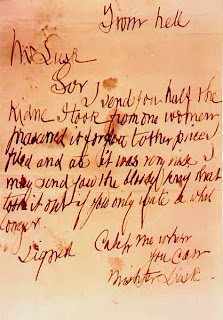Jack the Ripper
A recent article in the New York Times pointed out that it is the 125th anniversary of the killings attributed to Jack the Ripper. From the end of August to November 9, 1888, an unknown person murdered five prostitutes, which have come to be known as the "canonical" murders (others think he killed more, still others less). Today, 125 years ago, the body of Mary Kelly was discovered, completely mutilated and eviscerated.
The case of Jack the Ripper (the name came from a letter that is today considered a hoax) has been endlessly fascinating since then. The article pointed out that there are numerous tours that lead the interested through Whitechapel, the section of London where the killings took place. I took such a tour when I visited London over 20 years ago (today it is a largely Bangladeshi neighborhood). Apparently the business is much more flourishing today, as competing tours bump into each other, and some liven things up with guides in period costume.
So what is the hook here? A few things, I think. First, it is one of the great unsolved crimes in history, and is unlikely, given the destroyed evidence, to ever be solved. There are as many theories as there are those with theories, with suspects ranging far afield, from some anonymous Jewish leather worker to the Queen's grandson, the Duke of Clarence (this last suspect, though thoroughly exonerated, makes for the best fiction on the case, and is the subject of the best movies on the subject, which I'll take a look at in the coming weeks).
Secondly, the time period seems to go hand in hand with the mystery. Victorian gaslight England is catnip to some, especially literary types. Dare I say there is almost a romantic aspect to the case, even though the women were streetwalkers and the killings were excessively brutal. Googling images of Jack the Ripper bring up several photos of men in capes and top hats, standing in pools of light, their victims beneath them on bloodstained cobblestones. It is the same period as Sherlock Holmes and Dracula, and at times almost seems like yet another bit of fiction.
The case also has an almost fictive collection of ephemera that is common knowledge to those called "ripperologists." There are the letters sent, which may all have been hoaxes (the "From Hell" letter, pictured above, may be authentic), and the Goulston Street graffito, a handwritten message on a wall above a clue which was amazingly ordered erased by the police because it might have incited anti-Semitic violence. The victims and dates of the crimes are all well-known, having occurred toward the end of the months in question, including two on one night, "the double event."
It is these victims that have induced some outcry. In can be easy to start thinking of Jack the Ripper, whoever he was, as a fictional character, like Dracula or the Phantom of the Opera, and it can be fun to go on these tours. But a good tour guide will caution that these five women were all very real, and suffered horribly gruesome deaths. So the Disneyfication of it can be tasteless and disrespectful. I hope I can remember that as I continue to be fascinated by it.



Comments
Post a Comment